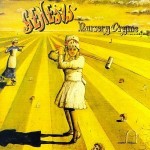BBQ gaulois et concert « rock progressif des années 70 »
 Extrait de Wikipedia (http://fr.wikipedia.org/wiki/The_Watch)
Extrait de Wikipedia (http://fr.wikipedia.org/wiki/The_Watch)
Extrait de Wikipedia : http://en.wikipedia.org/wiki/Nursery_Cryme
Nursery Cryme is the third studio album by Genesis and was recorded and released in 1971. It is also the first album to feature the lineup of Peter Gabriel, Tony Banks, Mike Rutherford, Phil Collins, and Steve Hackett; the latter two replacing John Mayhew and Anthony Phillips, on drums and guitar respectively, in 1970. This lineup would remain consistent until Gabriel’s departure in 1975.
« The Musical Box » is a story with Victorian overtones and was indeed presented as a Victorian fairy story. The song is a ten-minute epic touching on themes of death, reincarnation and lust; set in Victorian England, the story told of two small children in a country house. The young girl, Cynthia, kills the young boy, Henry, by removing his head with a croquet mallet. The lyrics of the song itself start at the moment when Cynthia discovers Henry’s musical box, which played the nursery rhyme « Old King Cole » when she opens it. As this happens, Henry’s soul returns in a restored body. However, Henry starts aging very quickly but retaining a child’s mind and vision. The life that he will never have, and its desires, start to pass before his eyes. As Henry attempts to have Cynthia pursue his romantic desire, his nurse hears the noise and goes to the nursery to investigate. Acting on instinct, she throws the musical box at the now elderly-looking child, destroying them both. (This story can be found in the inside booklet of the Nursery Cryme album.) The album cover is also a depiction of this song and story: Cynthia, holds a croquet mallet – there is a hoop visible close by – but instead of croquet balls, there are a few heads lying on the ground.
The climax to the song concerns itself with Henry’s feelings towards Cynthia, representing his lustful view of her, shown by the words ‘She’s a lady, she is mine!’ and in the finale when Gabriel sings, ‘Why don’t you touch me? Touch me, NOW, NOW, NOW, NOW, NOW!’. In live performances, Peter Gabriel would wear an « old man » mask for the final verse and unzip the chest part of his black jumpsuit. Dramatic lighting would be used each time he shouted « NOW! » At the end of the song, Henry, the old man, would die.
This song includes uncredited writing contributions from former member Anthony Phillips, having been based on a 1969 demo by him and Rutherford called « F Sharp ». Pieces of the song also came from material the band had written for a documentary about the painter Michael Jackson – those recordings were never released at the time but ultimately appeared on the box set Genesis: 1970-1975.
This became one of Genesis’s more famous songs, acquiring status as of one of the band’s signature tunes from their progressive rock-era and was featured in their live repertoire right up to Phil Collins‘ departure after the We Can’t Dance tour in 1992, albeit with only the closing section being included as part of a medley. It was also released on 1973’s Genesis Live.
A Genesis tribute band, The Musical Box, is named after this song.
« For Absent Friends » is a short and understated folk-based song about two people going to church and praying for their deceased loved ones. It is also the first song by the band to feature drummer Phil Collins as the lead vocalist and was the first song written by the new members Collins and Steve Hackett within the band context.
Guitarist Steve Hackett recorded a waltz version of this song for his Watcher of the Skies: Genesis Revisited album, with vocals by Colin Blunstone.
Peter Gabriel‘s lyrics to « The Return of the Giant Hogweed » tell an apocalyptic story about a « regal hogweed » being brought from Russia by a Victorian explorer to the Royal Gardens at Kew. Later, after being planted by country gentlemen in their gardens, the hogweeds take on a life of their own and spread their seed throughout England, preparing for an onslaught. The citizens attempt to assault the hogweeds with herbicide, but the plants are immune. After a brief instrumental (subtitled « The Dance of the Giant Hogweed »), the song ends in a crashing climax where the hogweed reigns victorious over the human race.
The inspiration for the subject of the song is a large, phototoxic weed, Heracleum mantegazzianum which poses a hazard in the United Kingdom and other countries.
The song was a staple of Genesis’ live performances and appears on the Genesis Live album.
« The Fountain of Salmacis » tells the story of the nymph Salmacis who in Greek mythology attempted to rape Hermaphroditus. In the story Salmacis and Hermaphroditus become joined as one, which is mirrored in the lyrics where Peter Gabriel sings:
« We shall be one,
We shall be joined as one. »
The album version features much lead guitar work from Steve Hackett, and is remarkable for the epic sound of mellotron, in the beginning and the end. A live version is included on Three Sides Live.


